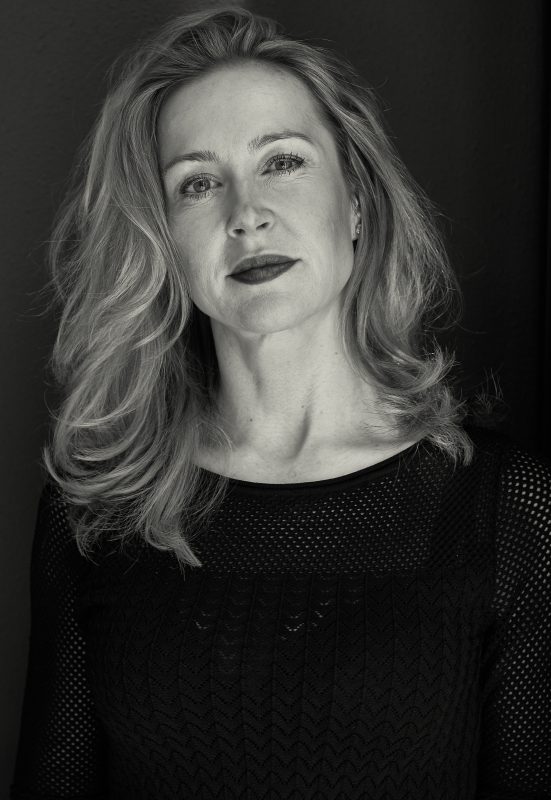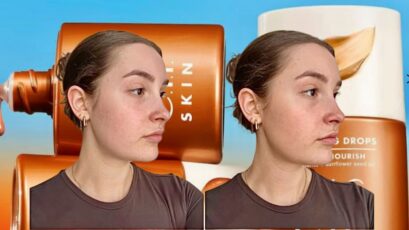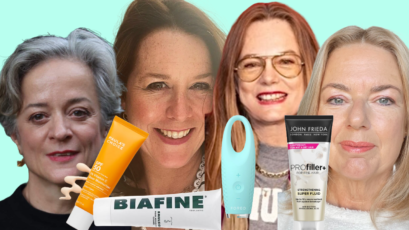This is the English version of the feature with plastic surgeon Franziska Lichtenegger on silicone breastimplants and the future….
For over 50 years, silicone breast prostheses have been used for aesthetic and reconstructive reasons. But there is a growing debate about the pros and cons of silicone. More and more women are going public with their complaints. There is also increasing attention in the media. Even the Dutch National Institute for Public Health and the Environment (RIVM) called on women earlier this year to come forward and file their complaints.
Encapsulation, ASIA, lymphoma…
Complaints vary from chest pain and hardening due to encapsulation (5.5% to 50%) to ASIA syndrome (autoimmune/inflammatory syndrome induced by adjuvants, estimated at 1 in 500) and the rare form of lymphoma called ALCL (anaplastic large cell lymphoma, a Non-Hodgkin cancer, estimated at 1 in 25,000). The latter also causes anxiety among plastic surgeons and scientists, as it is suspected that numbers may rise due to the ever-increasing global demand for breast implants.
Getting sick from plastic surgery?

Plastic surgeon Franziska Lichtenegger. Photographer: André La Croix
Although the number of cases of this lymphoma (1 in 25,000 in the Netherlands) is small among women wearing breast-prosthetics, it is still worrying. It is not clear what causes this condition. Scientists need insights to prevent worse. After all, these are healthy women who may be falling ill by body-embellishing methods.
What’s going on?
Are silicones to blame? Do they get into your body, making you sick? Or are there people whose bodies don’t tolerate any foreign materials – does their immune system go haywire, trying to drive them out?
Cause-effect
Is there any excessive bacterial growth when using certain types of prostheses, making you sick? And what is the causal link between prostheses and the risk of getting this type of lymphoma? Plastic surgeon Dr Franziska Lichtenegger has been in the field for 17 years. She is concerned about this new condition.
Rare form of cancer
“ALCL is not breast cancer, let’s be clear about that. It is a very rare form of lymphoma: a cancer of the immune cells, related to silicone breast prostheses. This type of cancer can occur in the scar tissue, in the capsule around the prosthesis, but also in fluids surrounding the prosthesis.”
32 known cases in The Netherlands
“An estimated 10 to 11 million women worldwide are wearing breast implants. Worldwide, there are now 359 known cases of ALCL (read more about these global figures). In The Netherlands, 25,000 – 30,000 women a year have implants. There have been 32 cases in The Netherlands so far. These figures show that instances of ALCL are exceptions. One in 25,000 women has a chance of developing this type of lymphoma.”
The role of the immune system
“Since 1990 a lot of research has been done into silicone and silicone prostheses, but silicone has not been proven harmful to the body so far. We need more research. The immune system could play a role in the development of this form of cancer.”
Bacterial accumulation in textured prostheses
“There is an increase in the use of so-called textured implants, with a roughened outer surface (said to reduce the risk of encapsulation, ed.). Medical cases show, however, that textured implants come with a higher risk. We suspect that bacteria immigrating from the skin of the patient, hide and accumulate in the rough surface. The body cannot get rid of them, igniting a permanent immune response, which may lead to lymphoma. Therefore sterile working of the surgeon is mandatory.”
FDA March 2017: very low risk
“Nevertheless, I would like to emphasize that clients with textured prostheses should not become too anxious now. In March 2017, the American food inspection authority (FDA) published a report on ALCL, indicating that there is a very small risk for these women. All brands of prostheses may still be used. Just watch your breasts closely. Is one of them getting bigger, or both, is there any asymmetry? Are there any changes in shape, do you have sharp pain in your breasts? Are there any fatigue problems?”
Symptoms and control
“Most patients are cured by surgical removal of both the implant and the capsule and fluid around it. If you develop any of the complaints mentioned above, have an echo done immediately to check if there is any fluid around the breasts. The sooner it will be discovered, the better. See your plastic surgeon.”
More attention also reveals more cases
Attention to ALCL lymphoma grew after women died of this disease. “As both clients and doctors become more alert, more cases are revealed. Also, the fact that the number of breast augmentations worldwide continues to increase will logically lead to more known cases. It is our job as plastic surgeons to discuss risks like ALCL with our clients.”
Registration now mandatory
“I recently attended the Beauty through Science conference in Stockholm, where it was emphasized that plastic surgeons need to keep a close eye on this condition. The Dutch government has also made it mandatory for doctors to register certain characteristics of the prostheses they use. Brand, type number, quality, size, the way in which it is inserted. This is how we hope to see, among other things, whether one brand or quality is more prone to ALCL development than the other.”
Women put off a doctor’s appointment
“As I said, if you have any complaints, see your doctor as soon as possible. Sometimes I see women who have had their prostheses for 20 years, who have hardened breasts and pain. That is not ALCL of course, but they do suffer because of encapsulation. I’m always surprised, thinking: ‘How is this possible? Why do you continue with this pain for so long? You pay so much attention to your appearance, yet you just keep going with these hard, painful breasts?’. You always get excuses like: ‘I’ve been too busy’, or ‘I thought it wasn’t so bad’.”
If breasts don’t feel soft, something’s wrong
“Breasts should feel soft. At all times. If they don’t, something is wrong. Obviously, you may be a little shy talk to your doctor about this, but there is a chance that a prosthesis is broken and an operation is needed. Related complaints like fatigue are often wiped away. Yet afterwards, many women are surprised how much better they feel after the implant has been renewed.”
Do your clients also have more complaints?
“No. I always ask my clients to come back. I have almost no clients with encapsulation and none of them have developed ASIA syndrome or lymphoma. In the rare case that a client comes to me with encapsulation problems, I always send the prosthesis back to the manufacturer after removal, asking for an analysis of the quality of the implant, how much silicone has been lost, etcetera.”
Do you still use textured prostheses?
“Only if a client chooses drop-shaped prostheses, because they will start to shift and turn otherwise. I prefer prostheses with a very smooth surface now, to keep bacteria from attaching themselves too easily. I place them underneath the muscle, which in my opinion also diminishes the risk of encapsulation. I give information and advice, but the final decision on the type of prosthesis is always made by the client herself.”
Manufacturers are far too reluctant
“As doctors and scientists we are currently in a situation where we are getting more questions. We don’t have all the answers yet. Part of our responsibility as doctors is to help get more clarity, and that can only happen if we document everything thoroughly. We need manufacturers to co-operate here, they are being far too reluctant. We should not rely on some government to get this thing going, because they often wait for things to go terribly wrong before they act. We must stay ahead.”
Active marketing for new prostheses: feeding on fear?
“Manufacturers are keen to use fear as a commercial driver. They are introducing new models that claim a lesser risk of encapsulation and complications because their textured surface is less rough. It’s just marketing, there is no evidence for it. They have only been on the market for a short time.”
“In addition, these are very soft and fluid prostheses, which can increase the risk of tearing because they move too much. I’m also starting to see prostheses with microchips that can store data. Again, we do not know how durable they are. I would say, just keep a proper administration, and you won’t need all that. ”
Do you still like working with silicone prostheses?
“Personally, I prefer lipofilling, filling the breasts with the client’s own fat tissue. Today, this method is mainly chosen by women who are having their prostheses removed. If they have enough fat, the breast can slowly be built up again. You can never go straight from a cup A to a cup C. Some of your own fat tissue will be broken down, so you mostly need multiple sessions depending on the expected breast size. Because it’s your own tissue, it feels very natural. And the results are great.”
Choosing for lipofilling
“However, if a young woman comes to me with an AA cup and no body fat to harvest, it will have to be a prosthesis. You see, when a woman has mentally crossed that bridge and decided to have a breast augmentation, she will not want to go back. She isn’t really open to the pros and cons anymore. The wish is too strong. So I will continue to use prostheses, in a safe and controlled way.”
Have your prostheses checked every five years
“It’s important to keep a close eye on your breasts. Also, have your prostheses checked regularly. Don’t be the woman who carries on for 20 years, have an echo done every 5 years. Always check with your plastic surgeon if you have any doubts or questions. Just to be sure.”
Save for new prostheses, you will need them
Finally, Franziska Lichtenegger emphasizes the importance of putting money aside for new prostheses. One day they will have to be replaced, that much is certain. You’ll have to pay for the prostheses and the surgery yourself. “I always say: be fully aware what you’re getting into. It is a lifelong trajectory, because of these replacements. Especially young women tend to underestimate that.”




